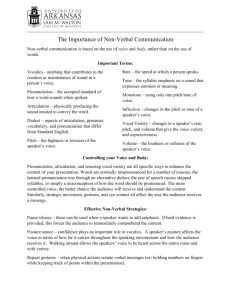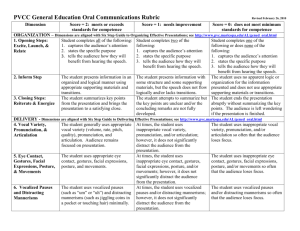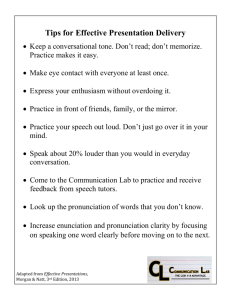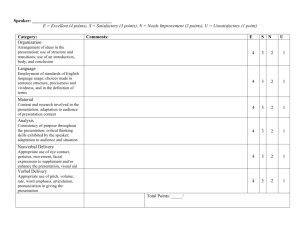Rubric for the Assessment of Recreation Therapy Interview Levels of Achievement Name:
advertisement
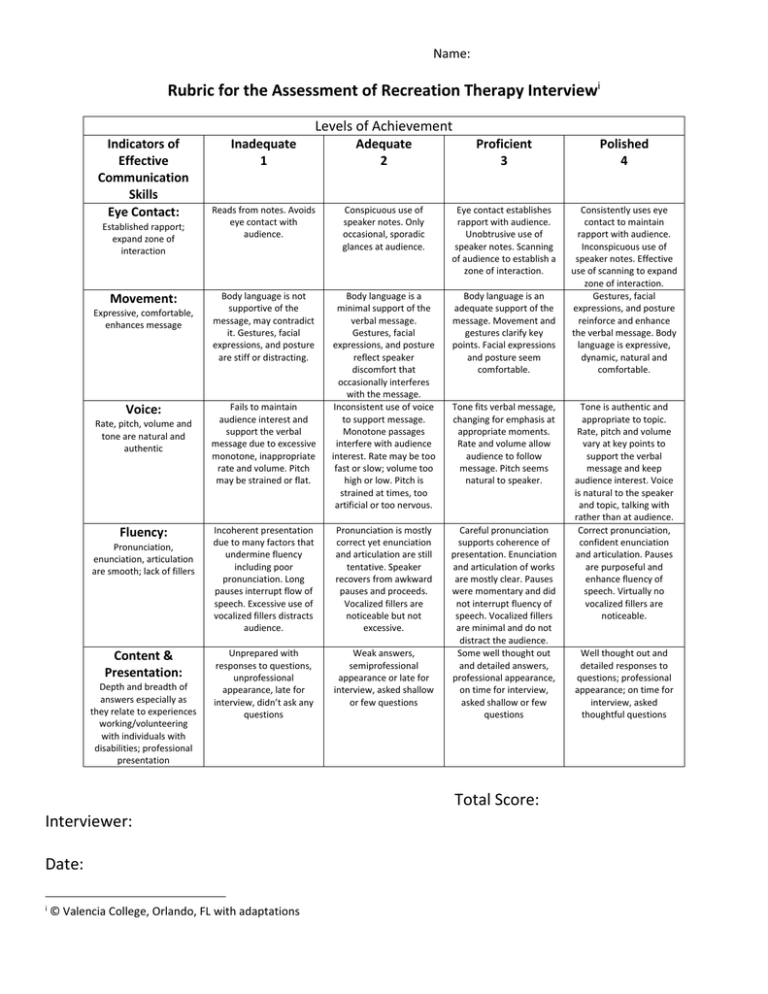
Name: Rubric for the Assessment of Recreation Therapy Interviewi Levels of Achievement Indicators of Effective Communication Skills Eye Contact: Established rapport; expand zone of interaction Movement: Expressive, comfortable, enhances message Voice: Rate, pitch, volume and tone are natural and authentic Fluency: Pronunciation, enunciation, articulation are smooth; lack of fillers Content & Presentation: Depth and breadth of answers especially as they relate to experiences working/volunteering with individuals with disabilities; professional presentation Inadequate 1 Adequate 2 Proficient 3 Polished 4 Reads from notes. Avoids eye contact with audience. Conspicuous use of speaker notes. Only occasional, sporadic glances at audience. Eye contact establishes rapport with audience. Unobtrusive use of speaker notes. Scanning of audience to establish a zone of interaction. Body language is not supportive of the message, may contradict it. Gestures, facial expressions, and posture are stiff or distracting. Body language is a minimal support of the verbal message. Gestures, facial expressions, and posture reflect speaker discomfort that occasionally interferes with the message. Inconsistent use of voice to support message. Monotone passages interfere with audience interest. Rate may be too fast or slow; volume too high or low. Pitch is strained at times, too artificial or too nervous. Body language is an adequate support of the message. Movement and gestures clarify key points. Facial expressions and posture seem comfortable. Consistently uses eye contact to maintain rapport with audience. Inconspicuous use of speaker notes. Effective use of scanning to expand zone of interaction. Gestures, facial expressions, and posture reinforce and enhance the verbal message. Body language is expressive, dynamic, natural and comfortable. Incoherent presentation due to many factors that undermine fluency including poor pronunciation. Long pauses interrupt flow of speech. Excessive use of vocalized fillers distracts audience. Pronunciation is mostly correct yet enunciation and articulation are still tentative. Speaker recovers from awkward pauses and proceeds. Vocalized fillers are noticeable but not excessive. Unprepared with responses to questions, unprofessional appearance, late for interview, didn’t ask any questions Weak answers, semiprofessional appearance or late for interview, asked shallow or few questions Careful pronunciation supports coherence of presentation. Enunciation and articulation of works are mostly clear. Pauses were momentary and did not interrupt fluency of speech. Vocalized fillers are minimal and do not distract the audience. Some well thought out and detailed answers, professional appearance, on time for interview, asked shallow or few questions Fails to maintain audience interest and support the verbal message due to excessive monotone, inappropriate rate and volume. Pitch may be strained or flat. Tone fits verbal message, changing for emphasis at appropriate moments. Rate and volume allow audience to follow message. Pitch seems natural to speaker. Total Score: Interviewer: Date: i © Valencia College, Orlando, FL with adaptations Tone is authentic and appropriate to topic. Rate, pitch and volume vary at key points to support the verbal message and keep audience interest. Voice is natural to the speaker and topic, talking with rather than at audience. Correct pronunciation, confident enunciation and articulation. Pauses are purposeful and enhance fluency of speech. Virtually no vocalized fillers are noticeable. Well thought out and detailed responses to questions; professional appearance; on time for interview, asked thoughtful questions
